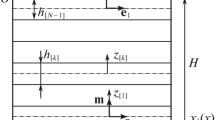Abstract
In this paper, the classical solution of the opening mode crack in the 90° layer of 0/90/0 laminates has been determined by means of Fourier transformations and the procedure of Copson for a pair of dual integral equations. The fracture behavior and the in situ transverse strength of the 90° layer have been quantitatively studied in graphite/epoxy laminates, based on the solution obtained above.
The results show that the stress intensity factor of this kind of laminates, which is different from that of a single unidirectional 90° layer, decreases with the increase in thicknessb, or modulusE L orG LT of the 0° layer and also decreases with the decrease in the thickness of the 90° layer. So the lamination effect manifests itself and thein situ transverse strength of the 90° layer is thereby enchanced. The theoretical calculations agree with the experimental data presented by D.L. Flaggs.
Similar content being viewed by others
References
Flaggs, D. L. and Kural, M. H.,J. Comp. Materials,16 (1982), 103–116.
Bailey, J. E., Curtis, P. T. and Parvizi, A.,Proc. R. Soc. Lond.,A. 366 (1979), 599–623.
Yamada, S. E. and Sun, C. T.,J. Comp. Materials,12 (1978), 275–284.
Korczyskyj, Y., Harris, S. J. and Morley, J. G.,J. Mat. Sci.,16 (1981), 1533–1547.
Ji Xing, Hsiao, G. C. and Chou, T. W.,J. Comp. Materials,15 (1981), 443.
Manders, P. W. and Bader, M. G.,J. Mat. Sci.,16 (1981), 2233–2245.
Fukunaga, H., Chou, T. W. & Peters, P. W. M.,J. Comp. Materials,18 (1984), 339–356.
Flaggs, D. L.,J. Comp. Materials,19 (1985), 29–50.
Wang, A. S. D., Proc. of The Third Inter. Conf. on Comp. Materials (1980), 178–185.
Wang, A. S. D. and Crossman, F. W., Final Tech. Rept, AFOSR Contract F49620-79-c-0206 (1982).
Wang, A. S. D., Chou, P. C. and Lei, S. C.,J. Comp. Materials,18 (1984), 239–254.
Erdogan, F. and Bakioglu, M.,Int. J. of Fracture,12 (1976), 71–84.
Erdogan, F. and Bakioglu, M.,Int, J. of Fracture,13 (1977), 739–759.
Delale, F. and Erdogan, F.,Int. J. of Fracture,15 (1979), 343–364.
Sih, G. C., Mechanics of Fracture-Crack in Composite Materials, Martinus Nijhoff Publisher (1981).
Copson, E. T., Proc. of Glasgow Mathematical Association,5 (1961), 19–24.
A Handbook of Stress Intensity Factors, Edited Chiefly by Chinese Aeronautical Establishment, Science Publishing House (1981), (in Chinese).
Author information
Authors and Affiliations
Additional information
Supported by National Natural Science Fundation of China.
Rights and permissions
About this article
Cite this article
Fuqun, F., Wanlin, D. & Jianxiang, W. A study of the in situ transverse tensile lamina strength and the classical solution of the opening mode crack in a 0/90/0 laminate. Acta Mech Sinica 4, 327–336 (1988). https://doi.org/10.1007/BF02486666
Received:
Issue Date:
DOI: https://doi.org/10.1007/BF02486666




